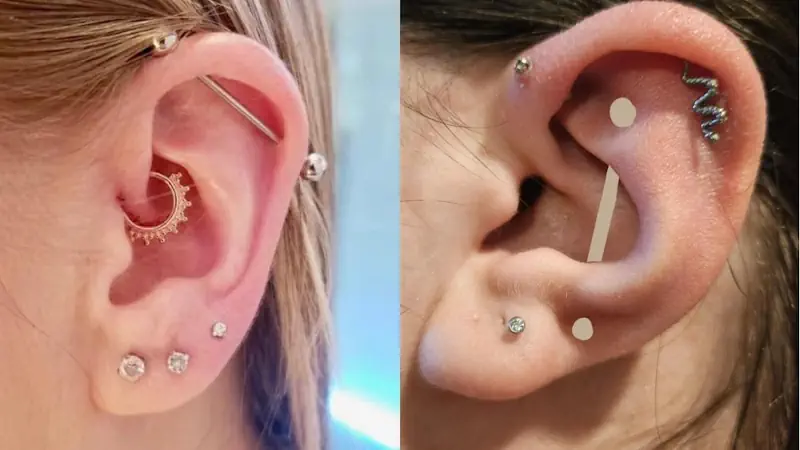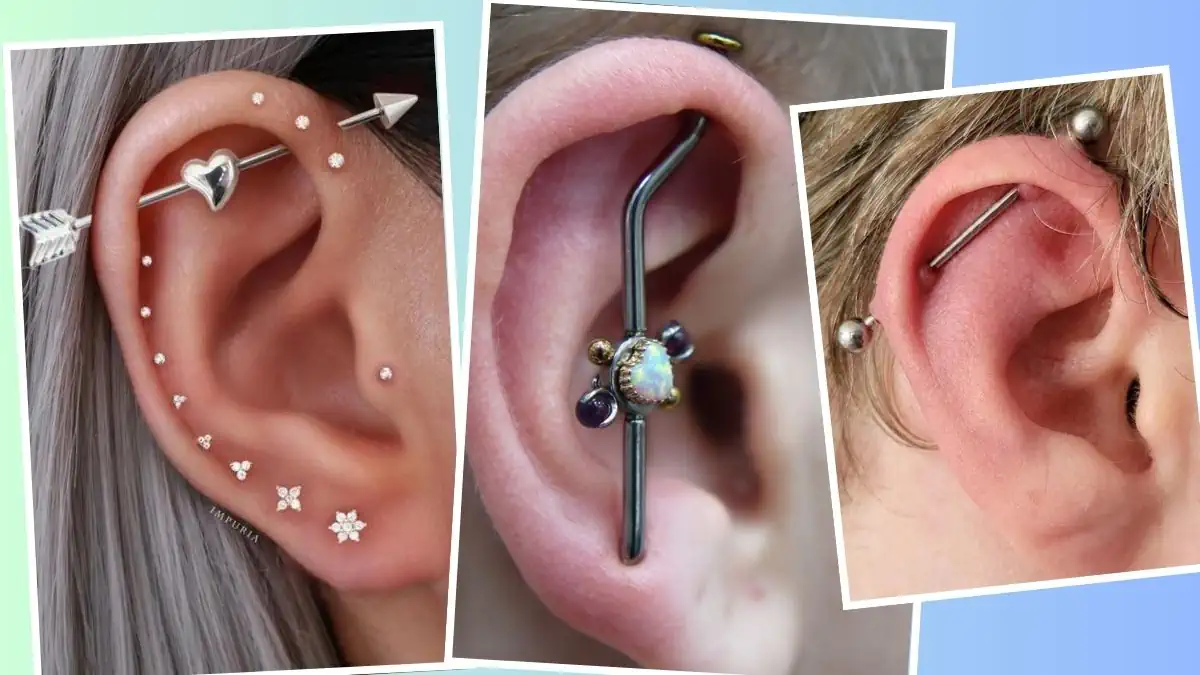Are you considering getting an industrial piercing? This edgy and stylish ear piercing has surged in popularity in recent years. But what exactly is an industrial piercing, and what do you need to know before taking the plunge?
In this comprehensive guide, we’ll cover everything from the basics of industrial piercings to aftercare tips to help your new piercing heal beautifully.
What is an Industrial Piercing?
An industrial piercing, also known as a scaffold piercing or bar piercing, is a type of ear cartilage piercing that typically consists of two holes connected by a single straight barbell. The most common placement is in the upper cartilage of the ear, going from the forward helix to the rear helix. However, there are many variations in placement depending on your ear anatomy and personal style preferences.
The industrial piercing gets its name from the 14 gauge barbell that is commonly used, which resembles a piece of industrial hardware. The look is bold and can really make a statement. Many people love industrial piercings because they offer an edgy, punk rock vibe.
Is an Industrial Piercing Right For You?
Before getting an industrial piercing, it’s important to consider a few factors:
- Anatomy – Not everyone has the right ear shape and cartilage structure to support an industrial piercing. A skilled piercer can assess your ears and recommend alternative placements if needed.
- Pain tolerance – Industrial piercings go through a thick section of cartilage, so they tend to be more painful than standard lobe piercings. If you have a low pain tolerance, an industrial may not be the best choice.
- Healing time – Cartilage piercings like industrials take longer to heal than lobe piercings, usually 6-12 months’ll need to be diligent about aftercare during this period.
- Lifestyle – Because industrials are more prone to getting bumped or snagged, you may want to avoid them if you play contact sports or regularly wear headphones.
What to Expect During the Piercing Process

Getting an industrial piercing is a bit more involved than a standard lobe piercing. Here’s a general overview of what to expect:
- The piercer will examine your ear anatomy to determine the optimal placement for your industrial. They may mark the entry and exit points with a pen.
- Your ear will be cleaned and sterilized. The piercer will use a hollow needle to create the two holes, then insert the barbell jewelry.
- You may feel some pain and pressure during the procedure, but it will be brief. Take deep breaths and try to relax.
- Once the jewelry is in place, the piercer will give you detailed aftercare instructions. Follow these carefully to prevent infection and promote healing.
The whole process usually takes less than 10 minutes. Make sure you go to a reputable piercing studio that uses sterile equipment and high-quality jewelry to minimize risks.
Choosing the Right Jewelry
The initial barbell used for an industrial piercing is usually a 14 gauge surgical stainless steel barbell that’s 1.5″ long. Once the piercing is fully healed, you can switch to other materials like titanium or gold.
There are many different styles of industrial barbells available, from simple and sleek to highly embellished. Some popular variations include:
- Spiked barbells
- Jeweled barbells
- Colored anodized titanium
- Twisted or spiral designs
When choosing jewelry, always make sure it’s the correct gauge and length for your piercing. Improperly fitted jewelry can cause irritation and prolong the healing process.
Proper Aftercare for Industrial Piercings
Aftercare is critical for preventing infection and ensuring your industrial piercing heals properly. Here are some essential care tips:
- Wash your hands thoroughly before touching your piercing.
- Clean the piercing twice a day with sterile saline solution or an antimicrobial soap. Avoid harsh products like alcohol or hydrogen peroxide.
- Gently pat the area dry with a clean paper towel. Avoid cloth towels which can harbor bacteria.
- Don’t twist or rotate the jewelry, as this can irritate the healing skin.
- Avoid sleeping on the pierced side. Use a travel pillow or donut-shaped pillow to keep pressure off the area.
- Keep hair products, cosmetics, and other potential irritants away from the piercing.
- Don’t submerge the piercing in pools, hot tubs, lakes, etc. until fully healed.
Be patient – it can take up to a year for an industrial piercing to heal completely. Don’t change the jewelry prematurely. If you experience prolonged redness, swelling, discharge or other signs of infection, see your piercer or doctor right away.
Dealing with Healing Complications
Even with proper aftercare, cartilage piercings like industrials can sometimes develop complications during the healing process. Some common issues include:
- Piercing bumps – These are small fluid-filled bumps that can form around the piercing site. They are often caused by trauma/irritation to the area. Careful cleaning and avoiding further irritation will usually resolve them.
- Migration/rejection – Sometimes the body will “reject” a piercing, pushing the jewelry towards the surface. This is more likely with improperly placed piercings. If you notice the bar seeming to grow shallower, see your piercer.
- Infection – Infections can occur if bacteria get into the open wound. Symptoms include severe redness, swelling, pain and discharge. Prompt treatment with antibiotics is necessary.
If you’re concerned about any symptoms, it’s always best to get checked out by a professional piercer or dermatologist familiar with body piercings. They can advise you on the best course of treatment.
Styling an Industrial Piercing
One of the great things about industrial piercings is their versatility when it comes to personal style. Here are a few ideas for rocking your new piercing:
- Minimalist industrial – Keep it simple and edgy with a classic barbell in a metal tone that complements your skin.
- Colorful industrial – Add a pop of color with an anodized titanium barbell in your favorite hue.
- Embellished industrial – Go for a glamorous look with a jeweled or intricately designed barbell.
- Coordinated ear party – Mix and match other ear piercings like helixes, flats, and lobes for a curated ear look.
The key is choosing jewelry that reflects your personal aesthetic and lifestyle. Don’t be afraid to change up your look once the piercing is fully healed – that’s part of the fun!
Getting an industrial piercing can be a bold way to express your individual style. While these piercings do require some extra TLC and mindful aftercare practices, the striking look is worth it for many. If you’re considering an industrial piercing, find an experienced piercer who can guide you through the process and help you achieve your desired aesthetic. Rock on!













